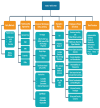A Comprehensive Survey of Machine Learning Techniques and Models for Object Detection
- PMID: 39797004
- PMCID: PMC11723456
- DOI: 10.3390/s25010214
A Comprehensive Survey of Machine Learning Techniques and Models for Object Detection
Abstract
Object detection is a pivotal research domain within computer vision, with applications spanning from autonomous vehicles to medical diagnostics. This comprehensive survey presents an in-depth analysis of the evolution and significant advancements in object detection, emphasizing the critical role of machine learning (ML) and deep learning (DL) techniques. We explore a wide spectrum of methodologies, ranging from traditional approaches to the latest DL models, thoroughly evaluating their performance, strengths, and limitations. Additionally, the survey delves into various metrics for assessing model effectiveness, including precision, recall, and intersection over union (IoU), while addressing ongoing challenges in the field, such as managing occlusions, varying object scales, and improving real-time processing capabilities. Furthermore, we critically examine recent breakthroughs, including advanced architectures like Transformers, and discuss challenges and future research directions aimed at overcoming existing barriers. By synthesizing current advancements, this survey provides valuable insights for enhancing the robustness, accuracy, and efficiency of object detection systems across diverse and challenging applications.
Keywords: deep learning; machine learning; models; object detection; techniques.
Conflict of interest statement
The authors declare no conflicts of interest.
Figures
References
-
- Amit Y., Felzenszwalb P., Girshick R. Computer Vision: A Reference Guide. Springer; Cham, Switzerland: 2021. Object detection; pp. 875–883.
-
- Trigka M., Dritsas E., Moustakas K. Joint Power and Contrast Shrinking in RGB Images with Exponential Smoothing; Proceedings of the 2022 IEEE 14th Image, Video, and Multidimensional Signal Processing Workshop (IVMSP); Nafplio, Greece. 26–29 June 2022; New York, NY, USA: IEEE; 2022. pp. 1–5.
-
- An L., Chen L., Hao X. Indoor Fire Detection Algorithm Based on Second-Order Exponential Smoothing and Information Fusion. Information. 2023;14:258. doi: 10.3390/info14050258. - DOI
-
- Zou Z., Chen K., Shi Z., Guo Y., Ye J. Object detection in 20 years: A survey. Proc. IEEE. 2023;111:257–276. doi: 10.1109/JPROC.2023.3238524. - DOI
Publication types
LinkOut - more resources
Full Text Sources


